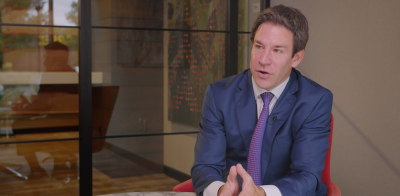This note has two parts. First, I’ll take you through what’s happening in equity markets and bond markets, then I’ll tell you what it all means for alternative investments. Context is always key, but if you’re anxious to get to the strategy portion of this note, feel free to jump ahead.
What’s happening in equity markets: The amazing, levitating S&P
Well, it’s déjà vu all over again in equity markets. Despite a historic pace of Fed tightening, the most aggressive quantitative tightening1 in history, unprecedented declines in money supply (at least since the Great Depression), and corporate earnings’ declines, the S&P 500 had levitated back to 19.7X the next 12 months expected earnings (which assign a zero percent probability of a recession in order to get 10% to 15% earnings growth). Now that the reality of stronger economic growth, higher rates for longer, and substantially higher long dated yields (10 year Treasury as an example) as the yield curve bear steepens is setting in, equity multiples have compressed back to 18.5X forward earnings.
Remember, we came into 2022 at a 21.2X multiple, declined to 15.8 by last October and did not completely roundtrip back to 21.2X, but at 19.7X; multiples had only declined by less than 10% over the past almost 21 months and at 18.5X have only declined by a little over 12.5%.
This brings us to a disconcerting price point for the risk/reward profile of equities going forward.
Expensive equities
Equities have been only more expensive twice in history on an absolute basis: 1) in the dot-com bubble and 2) during the later stages of the Fed- (and fiscal policy) driven post-pandemic risk-taking extravaganza of 2021.
More precariously, on a relative basis to the risk-free rate (measured by Fed Funds and 10-year Treasury yields) equities were only more expensive during the dot-com bubble—and we know how that turned out: The subsequent decade is now nostalgically referred to as the “Lost Decade.”
Are we headed for a Lost Decade?
We have not, and are still not, calling for a lost decade (21.2X, 19.7X and 18.5X are meaningfully less disconnected from reality than the 25X+ at the height of the dot-com bubble—plus there is just not enough precision and data to make that claim).
However, a key part of the Galactic Mean Reversion thesis is that after periods of outrageous financial asset outperformance relative to the cash-flowing-potential of the U.S. economy, markets tend to go through long hangover periods (aka sloppy, choppy messes where vanilla asset returns are much lower for an extended period of time.
This can be particularly acute when three of the key tailwinds that drove the outperformance are no longer tailwinds, in this case money-supply-growth greater than nominal gross domestic product (GDP) growth, lower and lower interest rates, and globalization providing a massive China labor pool supply shock. (Historically, as my brilliant colleague Lara Rhame has pointed out, when the starting point for equity valuations are in the top quintile—and guess where they are now—the forward returns for equities have been 5%, 3%, 2%, 2% and 2% over the next 1, 2, 3, 5 and 10 years).
A tough reality for equity markets
So even if you are the most ardent perma-bull in the world, you have to recognize future equity returns will look a lot more like the Lost Decade (2000 through 2009), 1964 to 1982, and January 2022 to the present, than March 7, 2009 through the end of 2021. Or put another way, you don’t have to be remotely bearish to understand it’s going to be tough to make a sustained buck in equity markets for a while.
Duration sensitive fixed income: Waiting for a collapse
Over in Duration Sensitive Fixed Income Land, the duration2 perma-bulls just keep waiting, and waiting and waiting for the economy to immediately collapse. Well, the wait will probably continue for at least the next quarter or two, and in the meanwhile, the higher income present in duration sensitive fixed income compared to 2021 keeps getting erased by higher and higher yields.
If the Fed can somehow, someway thread the needle and keep us out of recession for the next several years (not our base case), the pain of a continued bear steepening yield curve could be more than anyone relentlessly buying duration the past 19 months can bear (averaging down into oblivion). And, as a reminder, as money supply stagnates and continues to decline relative to nominal GDP, it not only impacts equity valuations but also bond prices and yields.
Is the upside worth the risk?
The other issue for being over one’s skis in duration risk is whether or not the upside in the next economic downturn is worth the near-term risk and mark-to-market volatility. Remember, unless the economy experiences a hard landing or there is an unforeseen market calamity, the probability of the Fed cutting rates back to zero is extremely low—and the quantitative easing (QE) era is over.
So, if the Fed cuts to 3% and the yield curve normalizes (with a higher 10-year yield than Fed funds rate), how much will 10-year Treasury yields drop? In my opinion, probably only 100 to 125 bps or so from here. Thus, you just don’t have as much “upside” to the next economic downturn as the past four recessions.
The Dare-to-Dream scenario: A mathematical path to avoiding recession
Now, let’s dare to dream.
Here’s what a soft landing might mean for equities, fixed income and credit markets.
Of course, this is a hypothetical—and there’s always the possibility that things don’t shake out this way—but if we’ve learned anything from the past market cycle: anything is possible.
As the U.S. economy continues to show remarkable resilience (for now) in the midst of the most rapid Fed tightening cycle in history, a massively inverted yield curve, stagnating bank lending, evaporating excess savings—and now flatlining to modestly declining withholding tax growth—at least there is a mathematical path to the Fed threading the needle and keeping the U.S. economy out of recession for the foreseeable future.
Remember, the U.S. economy is a consumption economy. And it really all comes down to whether or not the Fed can engineer enough of a softening of the labor market/rise in unemployment to declare victory over inflation without having labor market losses drive the economy into recession. It’s a tough, if not impossible, needle to thread if history is any guide.
However, the mathematical path to getting there runs through the combination of:
- Increased business fixed investment and construction spending driven by the Inflation Reduction Act
- The ability for most state and local governments to continue to spend freely
- The housing market flipping from a GDP detractor for six quarters to a sustained positive contributor based on hyper-tight supply
- And “labor hoarding” (when companies are highly reluctant to let workers go)
These would all collectively need to provide a positive feedback loop to short-circuit the typical Fed tightening/business cycle endgame where the lagging labor market is the last to break.
For the record, this is not our base case. It is still more likely than not that the endgame for this cycle is a mild recession. Hence the term “Dare to Dream.” But if hyper-perma-bullish growth managers can base entire industries and investment theses on hope, then more reality-constrained alternative asset managers can certainly focus on rosier scenarios for a select subset of strategies that have already exceeded expectations as recently as six to 12 months ago!
What it means for alternatives
So what does a Dare-to-Dream scenario mean for various asset classes and alternative strategies?
- Equities: Earnings declines will be pushed back for a while. But continued Fed tightening via quantitative tightening (QT), bear steepening yields curves, and elevated valuations will keep a lid on or compress equity multiples.
- Fixed income: You’ll earn your yield, but you will probably face further mark-to-market losses from bear steepening.
- Credit markets: For credit markets, and in particular floating rate3 private lending strategies, Dare to Dream is a nirvana scenario that could lead to higher yields and lower default rates.
These two potential benefits of the dare-to-dream scenario on credit markets are worth explaining in greater detail:
- Higher yields and income for longer—as we’ll be waiting a long, long time for any meaningful rate cuts from the Fed. At the end of 2021, few if any in the investment community (including ourselves) imagined the Fed funds rate would climb so fast and stick at those levels for potentially years. We have always been in the higher-for-longer camp, but what has unfolded so far (and could continue for while) has been a pleasant upside surprise indeed!
- Lower default rates for the foreseeable future, meaning less income given back through realized losses. Remember, credit strategies are all about maximizing income and minimizing realized losses by intelligently underwriting sectors, geographies, industries, leverage levels, quality of borrowers, covenants, etc., but invariably in economic downturns, defaults increase. That means a larger portion of income is given back through realized loss (default rate x loss severity, or default rate x (1-recovery-rate)). If the Fed can thread the needle, then realized losses will stay constrained as far as the eye can see and total return will be higher for longer as well.
Private floating rate loans: Higher income for longer
Additionally, private floating rate loans typically come with floors on the interest payments to better protect the lender’s income in the event the Fed aggressively cuts rates again. For instance, in commercial real estate (CRE) lending, newly originated loans have floors set around prevailing one-month Secured Overnight Financing Rate (SOFR) minus 1% to 1.5%. Additionally, floating rate CRE loans typically have a three-year term with two one-year extension options and existing loans with little if any floor protection (since the Fed funds rate was so gosh darn low for so long) roll-off over time.
So, another twinkle in the eye of the Dare-to-Dream scenario is that every month the Fed can keep rates at or above 5.25%–5.5% range, it increases the percentage of a lending portfolio’s floor protection from an eventual Fed rate cutting cycle. This in turn could lead to higher income for longer.
Multi-strategy funds
Additionally, the Dare-to-Dream scenario is not only a potential nirvana for floating rate private lending strategies, but also should extend higher levels of income and cash flow for longer for a select group of multi-strategy funds that participate directly from a higher risk-free rate. In some multi-strategy funds, a large portion of NAV not posted as margin for futures or total return swap positions is parked in cash and earns a risk-free return. Additionally, multi-strategy funds leaning into the “Cash Flow is King” master thesis will also benefit from higher income and cash flow in credit strategies.
Slow mortgage refinance activity
Lastly, multi-strategy funds that can take positions in securities that benefit from slow mortgage refinance activity primarily driven by a substantial rise in mortgage rates will have even higher noncorrelated income for longer in the Dare to Dream scenario than if the economy collapses tomorrow and the Fed cuts rates back to zero. This is because it will more than likely take a Fed funds at zero to get mortgage rates to a low enough level to drive up refinance activity substantially.
Conclusion: Northwest quadrant strategies
Remember, at these starting valuations, the outlook for equity returns is not terribly bright. Duration-sensitive fixed income may have much better risk/reward than the recent past, but it’s still paying modest income without much upside in the next downturn (and taking it on the chin again in the meanwhile). Plus, the potential for a continued round of bear steepening pain is meaningful.
Since the end of 2021, the northwest quadrant of the efficient frontier4 has been the place to be—and will potentially be for the foreseeable future (why the heck would you take meaningfully more risk for possibly lower returns)!? Floating rate private lending strategies, and certain multi-strategy funds, are classic northwest quadrant strategies and may offer attractive risk-adjusted returns throughout an economic and market cycle.
Furthermore, in the Dare-to-Dream scenario, both income AND total return may be higher for these strategies for longer. Who doesn’t like higher income and total return for longer? Let me know if you find that investor.
Up next: Private lending strategies and multi-strategy investing
Stay tuned for the next strategy note, when we’ll dive deeper into the evolving opportunity set for private lending strategies—and highlight key current themes in multi-strategy investing.
In the meanwhile: “Dare to Dream.”
Investing in alternatives is different than investing in traditional investments such as stocks and bonds. Alternatives tend to be illiquid and highly specialized. In the context of alternative investments, higher returns may be accompanied by increased risk and, like any investment, the possibility of an investment loss. Investments made in alternatives may be less liquid and harder to value than investments made in large, publicly traded corporations. When building a portfolio that includes alternative investments, financial professionals and their investors should first consider an individual’s financial objectives. Investment constraints such as risk tolerance, liquidity needs and investment time horizon should be determined.




